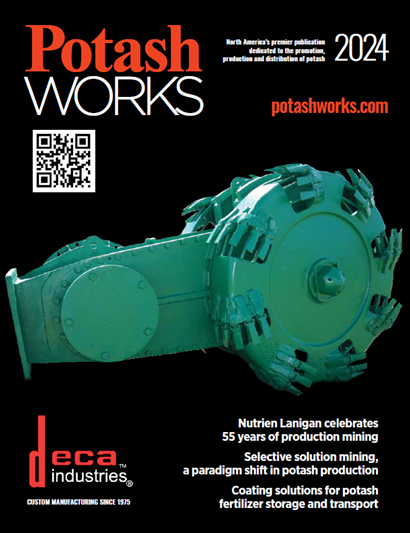Publication: PotashWorks 2024
Date: January 2024
Expert: Anand Sundararaman, PHD., Technical Manager of Crop Nutrition
Preserving Potash
Coating Solutions for Potash Fertilizer Storage and Transport
Annually, millions of tons of potash fertilizer products are exported globally, necessitating intricate logistics for transport and storage. This operation encompasses prolonged storage of potash within facilities and transfer under non-controlled environmental conditions. Bulk potash transport primarily leverages rail cars and maritime vessels in combination with conveyor belts.
One prevalent issue during conventional storage and transportation is the frequent occurrence of potash fertilizer agglomeration, often referred to as “caking”. Caking arises primarily due to cyclical fluctuations in humidity, influenced by day-to-night temperature changes. When humidity increases, moisture either condenses from the air or migrates out of the granules, initiating the dissolution of the fertilizer. Conversely, as humidity decreases and temperatures cool, re-crystallization leads to the formation of crystal bridges, creating salt bonds that bind granules together. These lumps and agglomerates typically form in fertilizer storage facilities or because of exposure to harsh environmental conditions during transit. The existence of solid clumps within the fertilizer adds complexity to the handling process during loading and transit. Furthermore, these lumps can impede equipment spreading, leading to uneven nutrient distribution and increased wear on the equipment.
In addition, the agglomerated fertilizer tends to generate dust during packaging or transportation due to the mechanical abrasion caused by the movement of the fertilizer particles and/or the migration of moisture through the fertilizer. This dust complicates handling and land distribution, as it can become airborne during application in the field. Consequently, it leads to uneven nutrient distribution and potential health and safety concerns for users.
It is important to note that the phenomenon of moisture accumulation within bulk potash occurs at the air-potash interface throughout various stages, commencing with mining processing and persisting until the final application of potash to the soil in conjunction with other fertilizers and additives. Figure 1 illustrates the effect of standard potash (KCl) fertilizer after exposure to 85 per cent RH at 30°C for eight hours.
To read the full article, please download the PDF.

